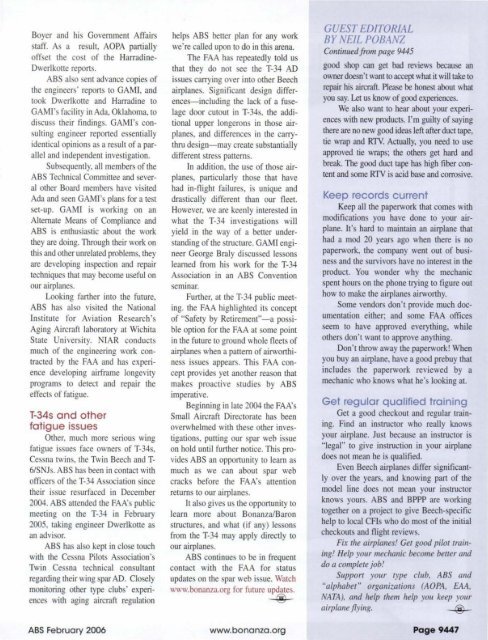Create successful ePaper yourself
Turn your PDF publications into a flip-book with our unique Google optimized e-Paper software.
Boyer and his Government Affairsstaff. As a result, AOPA partiallyoffset the cost of the HarradineDwerlkotte reports.ABS also sent advance copies ofthe engineers' reports to GAMI , andtook Dwerlkotte and Harradine toGAMI's facility in Ada, Oklahoma, todiscuss their iindings. GAMl's consultingengineer reported essentiallyidentical opinions as a result of a paralleland independent investigation.Subsequently, all members of theABS Technical ConUllittee and severalother Board members have visitedAda and seen GAMl's plans for a testset-up. GAMI is working on anAlternate Means of Compliance andABS is enthusiastic about the workthey are doing. Through their work onthis and other unrelated problems, theyare developing inspection and repairtechniques that may become useful onour airplanes.Looking farther into the future,ABS has also visited the NationalInstitute for Aviation Research 'sAging Aircraft laboratory at WichitaState Uni versity. NIAR conductsmuch of the engineering work contractedby the FAA and has experiencede veloping airframe longevityprograms to detect and repair theeffects of fatigue.T-34s and otherfatigue issuesOther. much more serious wingfat igue issues face owners of T-34s,Cessna twins, the Twin Beech and T-6/SNJs. ABS has been in contact withofficers of the T-34 Association sincethei r issue resurfaced in December2004. ABS attended the FAA's publicmeeting on the T-34 in <strong>February</strong>2005, taking engineer Dwerlkotte asan advisor.ABS has also kept in close touchwith the Cessna Pilots Association'sTwin Cessna technical consultantregarding their wing spar AD. Closelymonitoring other type clubs' experienceswith aging aircraft regulationABS <strong>February</strong> <strong>2006</strong>helps ABS better plan for any workwe' re called upon to do in this arena.The FAA has repeatedly told usthat they do not see the T-34 ADissues carrying over into other Beechairplanes. Significant design differences-includingthe lack of a fuselagedoor cutout in T-34s, the additionalupper longerons in those airplanes,and differences in the carrythrudesign- may create substantiallydifferent stress patterns.In addition, the use of those airplanes,particularly those that havehad in-flight failures, is unique anddrastically different than our fleet.However, we are keenly interested inwhat the T-34 investigations wi llyield in the way of a better understandingof the structure. GAM I engineerGeorge Braly di scussed lessonslearned from hi s work for the T-34Association in an ABS Conventionsemjnar.Further, at the T-34 public meeting.the FAA highlighted its conceptof "Safety by Retirement"-a possibleoption for the FAA at some pointin the future to ground whole fleets ofairplanes when a pattern of airworthinessissues appears. This FAA conceptprovides yet another reason thatmakes proactive studies by ABSimperative.Beginning in late 2004 the FAA'sSmall Aircraft Directorate has beenoverwhelmed with these other investigations,putting our spar web issueon hold until further notice. This providesABS an opportunity to learn asmuch as we can about spar webcracks before the FAA's attentionreturns to our airplanes.It al so gives us the opportunity tolearn more about <strong>Bonanza</strong>lBaronstructures, and what (if any) lessonsfrom the T-34 may apply directly toour airplanes.ABS continues to be in frequentcontact with the FAA for statusupdates on the spar web issue. Watchwww.bonanza.org for furure updates.~www.bonanza.orgGUEST EDITORIALBY NEIL POBANZCominued from page 9445good shop can get bad reviews because anowner doesn't want to accept what it will take torepair his aircraft. Please be honest about whatyou say. Let us know of good experiences.We also want to hear about your experienceswith new products. I'm guilty of sayingthere are no new good ideas left after duct rape,tie wrap and RTV. Actually, you need to useapproved tie wraps; the others get hard andbreak. The good duct rape has high fiber contentand some RTV is acid base and corrosive.Keep records currentKeep all the paperwork that comes withmodifications you have done to your airplane.It's hard to maintain an airplane thathad a mod 20 years ago when there is nopaperwork, the company went out of businessand the survivors have no interest in theproduct. You wonder why the mechanicspent hours on the phone trying to figure outhow to make the airplanes airworthy.Some vendors don 't provide much documentationeither; and some FAA officesseem to have approved everything, whileothers don't want to approve anything.Don 't throw away the paperwork' Whenyou buy an airplane, have a good prebuy thatincludes the paperwork reviewed by amechanic who knows what he's looking at.Get regular qualified trainingGet a good checkout and regular training.Find an instructor who really knowsyour airplane. Just because an instructor is"legal" to give instruction in your airplanedoes not mean he is qualified.Even Beech airplanes differ significantlyover the years, and knowing part of themodel line does not mean your instructorknows yours. ABS and BPPP are workingtogether on a project to give Beech-specifichelp to local CFls who do most of the iilltialcheckouts and flight review s.Fix the airplanes! eet good pilot training!Help ),our mechanic become better anddo a complete job!Support your type club, ABS and"alphabet" organizatiolls (AOPA, EAA,NATA ), and help them help you keep YOllrairplalle flyillg.-@-Page 9447

















